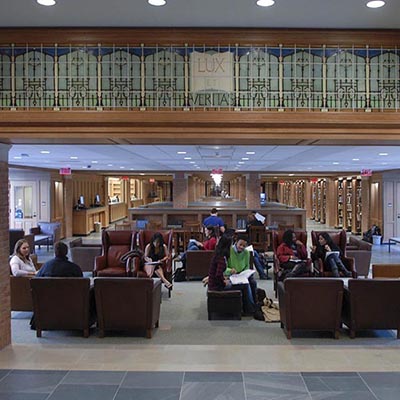
The Anne T. and Robert M. Bass Library will undergo renovation this summer to expand study space for the university’s growing undergraduate population. A newly revised plan calls for an increase in seating from 365 to 449 spaces and a smaller, updated print collection more closely aligned with today’s undergraduate curriculum.
“Through expanded study space, a renewed collection, and the move of two librarians to more visible, upper-level offices, we will make Bass a more effective gateway to all the resources of Yale University Library,” wrote Susan Gibbons, the Stephen F. Gates ’68 University Librarian and deputy provost for collections and scholarly communication, in a Feb. 7 email to the campus community.
The current Bass collection comprises 104,000 individual titles plus 41,000 duplicate copies, for a total of 145,000 volumes. To create more study space, the post-renovation collection will be approximately 61,000 volumes. All books removed from Bass will be re-shelved next door in the Sterling Memorial Library stacks, which have been recently reorganized.
“Going forward, we are committed to maintaining a more dynamic, up-to-date collection in Bass that will evolve with the addition of new courses and encourage students’ engagement with print books,” Gibbons said. “We envision a renewed focus on books by Yale faculty, critically acclaimed books, and works related to the undergraduate curriculum or recommended by faculty. The collection will be smaller, but more vital and relevant.”
Recognizing that some faculty and students oppose any reduction in the Bass collection, Gibbons frames the issue in terms of balancing competing needs. “With the student body increasing by 800, we want to make sure Bass remains a conducive and comfortable study space where students can reliably go and have a chance of finding a place to study,” she said. “When students study in the libraries, it creates opportunities for us to introduce them to all of our collections, services, and librarians.”
The two-story underground Bass Library opened in October 2007 after a top-to-bottom renovation transformed the former Cross Campus Library into a modern space with light-filled sunken courtyards. Over the past decade, Bass has remained a popular study location, but circulation of its collection materials dropped by almost half. In line with broader trends, the decline has been sharpest for undergraduates, whose borrowing represented 40% of the total circulation in 2008 and only 13% in 2018. Pre-renovation research indicated that undergraduates tend to choose Bass for focused work on specific projects rather than to browse or borrow from the collection.
“Declining use of print materials is a global trend, fueled by the proliferation of different ways to receive information and certainly not limited to Yale students,” Gibbons said. “However, we believe there are ways to re-conceptualize the Bass collection that will attract and engage more students with the collection.”
The project committee is using data about the composition of the Bass collection, together with data about print resource use across the entire library system, to experiment with different collection models, according to Assessment Librarian Sarah Tudesco, who chairs the renovation planning committee. The group has invited interested faculty and students to provide collection suggestions and recommendations using an online collection form on the project’s website or by contacting the relevant subject librarian.
Under the revised plan, the renovation is scheduled to be fully completed by Oct. 1. To minimize disruption to students, a “soft opening” is planned for the beginning of the semester, Aug. 28, so that returning students can study and work in the space while services, staffing, and other aspects of the project are being finished.
Completing the renovation and collection renewal is not the end of this process, Gibbons stressed. “Going forward, we will continue to assess how well the space and collections align with student needs and make further changes as needed. This is being designed as a dynamic space, that can be adapted to changing needs.”
Photo: Michael Marsland